Analysis of Motivation Theories: Marks and Spencer Case Study
VerifiedAdded on 2022/12/23
|7
|1663
|1
Essay
AI Summary
This essay delves into the realm of motivation theories, specifically examining their practical application within the context of Marks and Spencer, a prominent British multinational retailer. The essay commences with an introduction to the significance of motivation in organizational settings, emphasizing its role in enhancing employee performance and achieving company objectives. The main body of the essay then explores three core motivation theories: Maslow's Hierarchy of Needs, Herzberg's Two-Factor Theory, and Vroom's Expectancy Theory. For each theory, the essay provides a detailed explanation of its core principles and then analyzes how Marks and Spencer implements these principles to motivate its workforce. This includes examining how the company addresses employees' physiological, safety, social, esteem, and self-actualization needs (Maslow), the hygiene and motivational factors (Herzberg), and the expectancy, instrumentality, and valence components (Vroom). The essay concludes by summarizing the key findings and reiterating the importance of motivation in fostering a productive and efficient work environment.
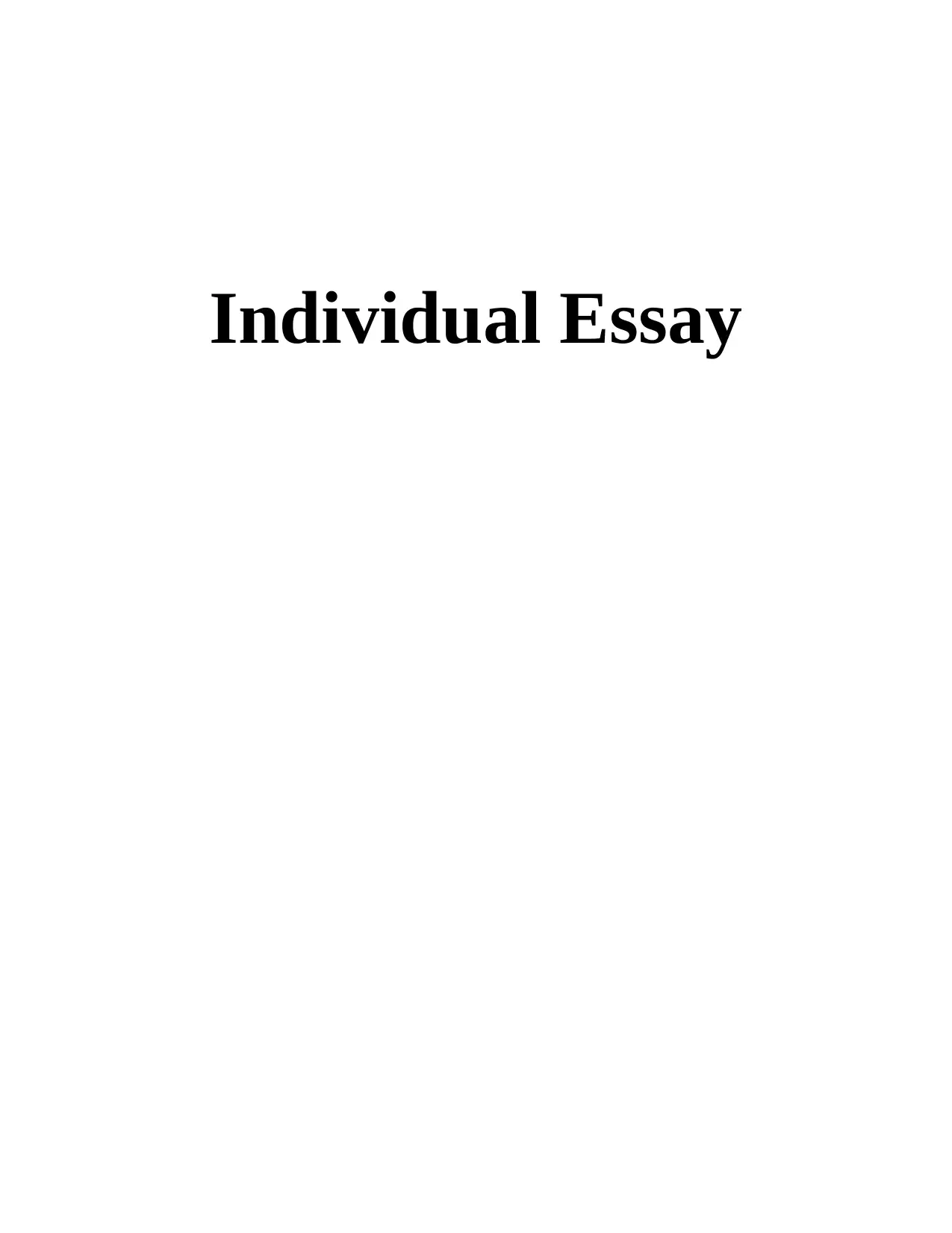
Individual Essay
Paraphrase This Document
Need a fresh take? Get an instant paraphrase of this document with our AI Paraphraser
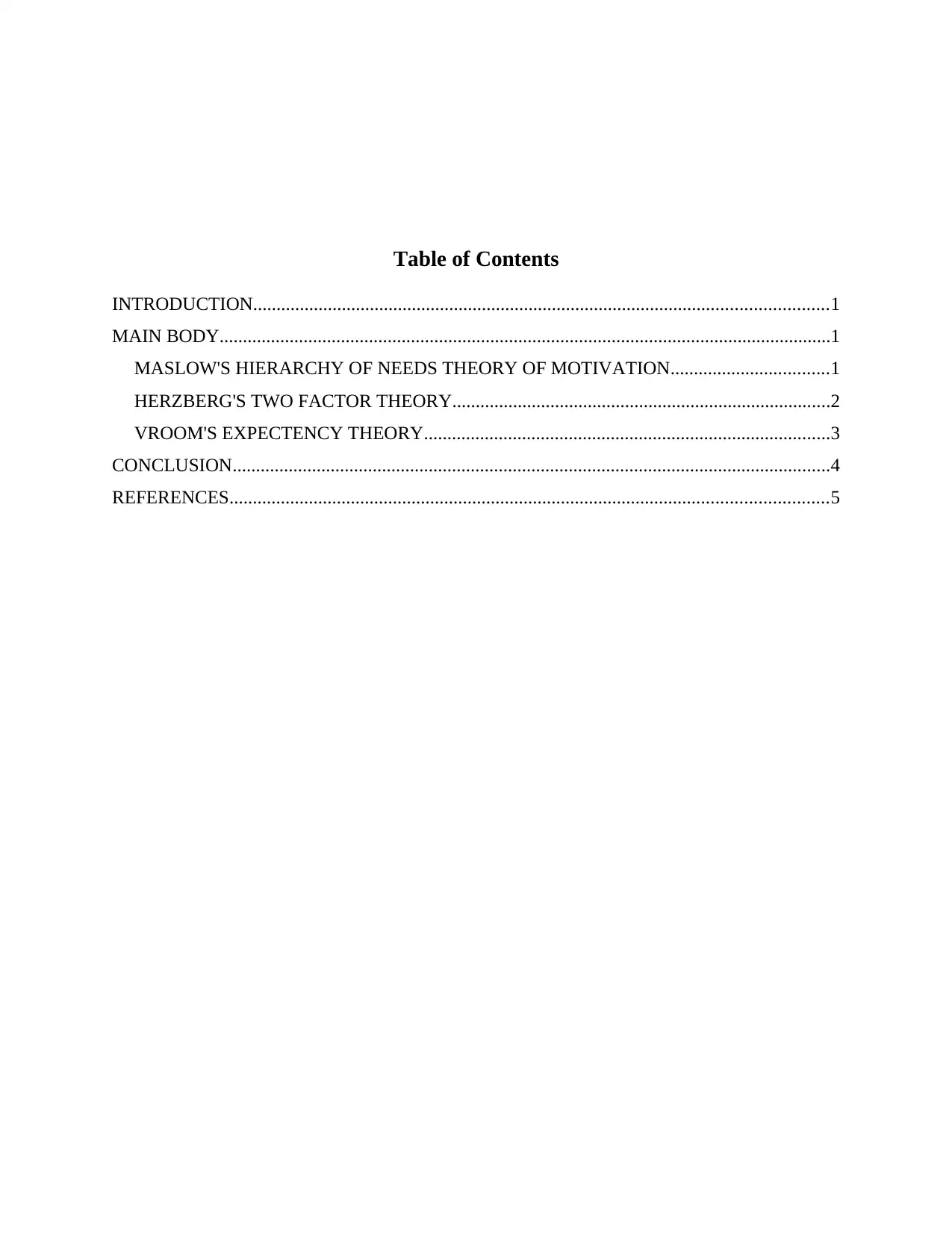
Table of Contents
INTRODUCTION...........................................................................................................................1
MAIN BODY...................................................................................................................................1
MASLOW'S HIERARCHY OF NEEDS THEORY OF MOTIVATION..................................1
HERZBERG'S TWO FACTOR THEORY.................................................................................2
VROOM'S EXPECTENCY THEORY.......................................................................................3
CONCLUSION................................................................................................................................4
REFERENCES................................................................................................................................5
INTRODUCTION...........................................................................................................................1
MAIN BODY...................................................................................................................................1
MASLOW'S HIERARCHY OF NEEDS THEORY OF MOTIVATION..................................1
HERZBERG'S TWO FACTOR THEORY.................................................................................2
VROOM'S EXPECTENCY THEORY.......................................................................................3
CONCLUSION................................................................................................................................4
REFERENCES................................................................................................................................5
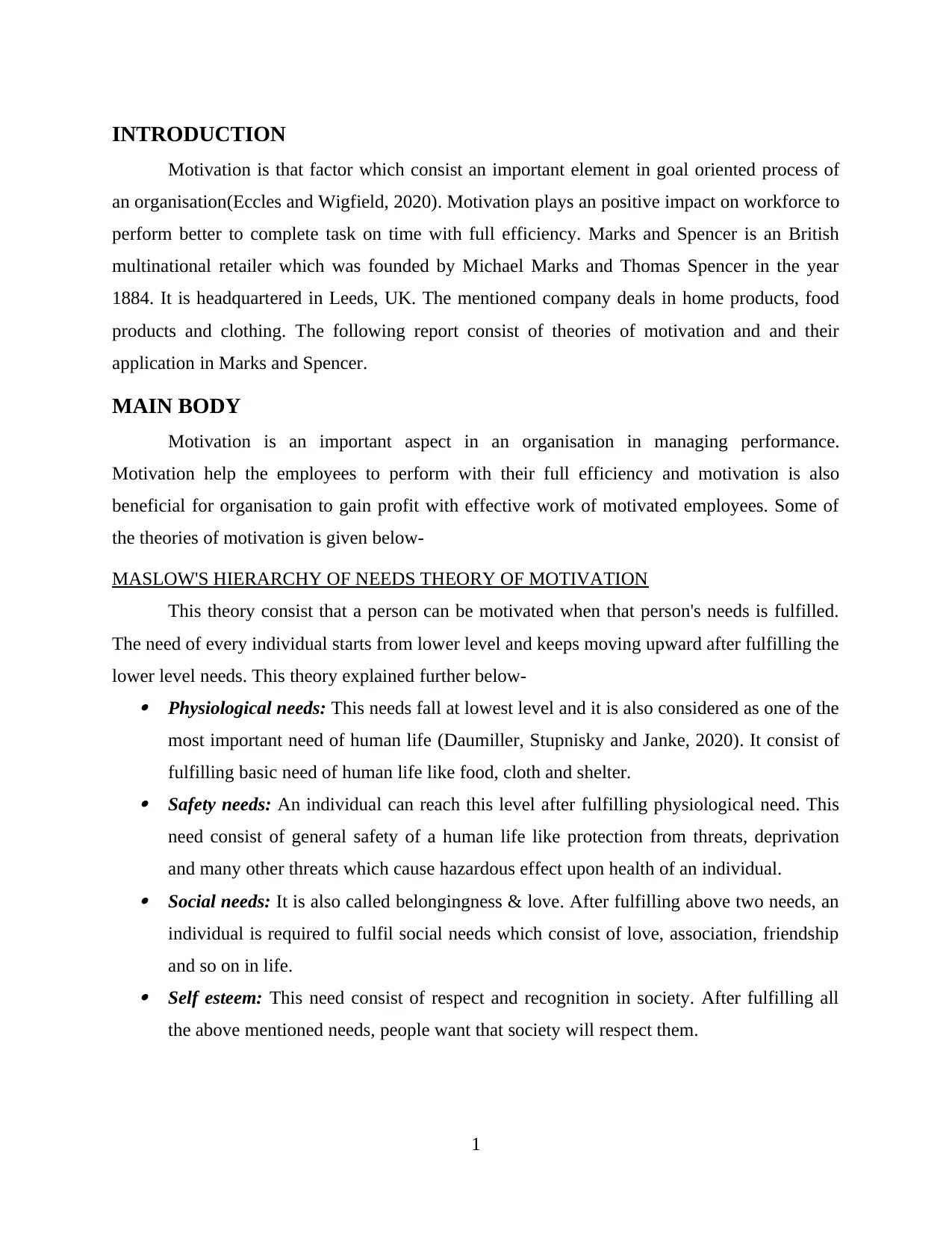
INTRODUCTION
Motivation is that factor which consist an important element in goal oriented process of
an organisation(Eccles and Wigfield, 2020). Motivation plays an positive impact on workforce to
perform better to complete task on time with full efficiency. Marks and Spencer is an British
multinational retailer which was founded by Michael Marks and Thomas Spencer in the year
1884. It is headquartered in Leeds, UK. The mentioned company deals in home products, food
products and clothing. The following report consist of theories of motivation and and their
application in Marks and Spencer.
MAIN BODY
Motivation is an important aspect in an organisation in managing performance.
Motivation help the employees to perform with their full efficiency and motivation is also
beneficial for organisation to gain profit with effective work of motivated employees. Some of
the theories of motivation is given below-
MASLOW'S HIERARCHY OF NEEDS THEORY OF MOTIVATION
This theory consist that a person can be motivated when that person's needs is fulfilled.
The need of every individual starts from lower level and keeps moving upward after fulfilling the
lower level needs. This theory explained further below- Physiological needs: This needs fall at lowest level and it is also considered as one of the
most important need of human life (Daumiller, Stupnisky and Janke, 2020). It consist of
fulfilling basic need of human life like food, cloth and shelter. Safety needs: An individual can reach this level after fulfilling physiological need. This
need consist of general safety of a human life like protection from threats, deprivation
and many other threats which cause hazardous effect upon health of an individual. Social needs: It is also called belongingness & love. After fulfilling above two needs, an
individual is required to fulfil social needs which consist of love, association, friendship
and so on in life. Self esteem: This need consist of respect and recognition in society. After fulfilling all
the above mentioned needs, people want that society will respect them.
1
Motivation is that factor which consist an important element in goal oriented process of
an organisation(Eccles and Wigfield, 2020). Motivation plays an positive impact on workforce to
perform better to complete task on time with full efficiency. Marks and Spencer is an British
multinational retailer which was founded by Michael Marks and Thomas Spencer in the year
1884. It is headquartered in Leeds, UK. The mentioned company deals in home products, food
products and clothing. The following report consist of theories of motivation and and their
application in Marks and Spencer.
MAIN BODY
Motivation is an important aspect in an organisation in managing performance.
Motivation help the employees to perform with their full efficiency and motivation is also
beneficial for organisation to gain profit with effective work of motivated employees. Some of
the theories of motivation is given below-
MASLOW'S HIERARCHY OF NEEDS THEORY OF MOTIVATION
This theory consist that a person can be motivated when that person's needs is fulfilled.
The need of every individual starts from lower level and keeps moving upward after fulfilling the
lower level needs. This theory explained further below- Physiological needs: This needs fall at lowest level and it is also considered as one of the
most important need of human life (Daumiller, Stupnisky and Janke, 2020). It consist of
fulfilling basic need of human life like food, cloth and shelter. Safety needs: An individual can reach this level after fulfilling physiological need. This
need consist of general safety of a human life like protection from threats, deprivation
and many other threats which cause hazardous effect upon health of an individual. Social needs: It is also called belongingness & love. After fulfilling above two needs, an
individual is required to fulfil social needs which consist of love, association, friendship
and so on in life. Self esteem: This need consist of respect and recognition in society. After fulfilling all
the above mentioned needs, people want that society will respect them.
1
⊘ This is a preview!⊘
Do you want full access?
Subscribe today to unlock all pages.

Trusted by 1+ million students worldwide
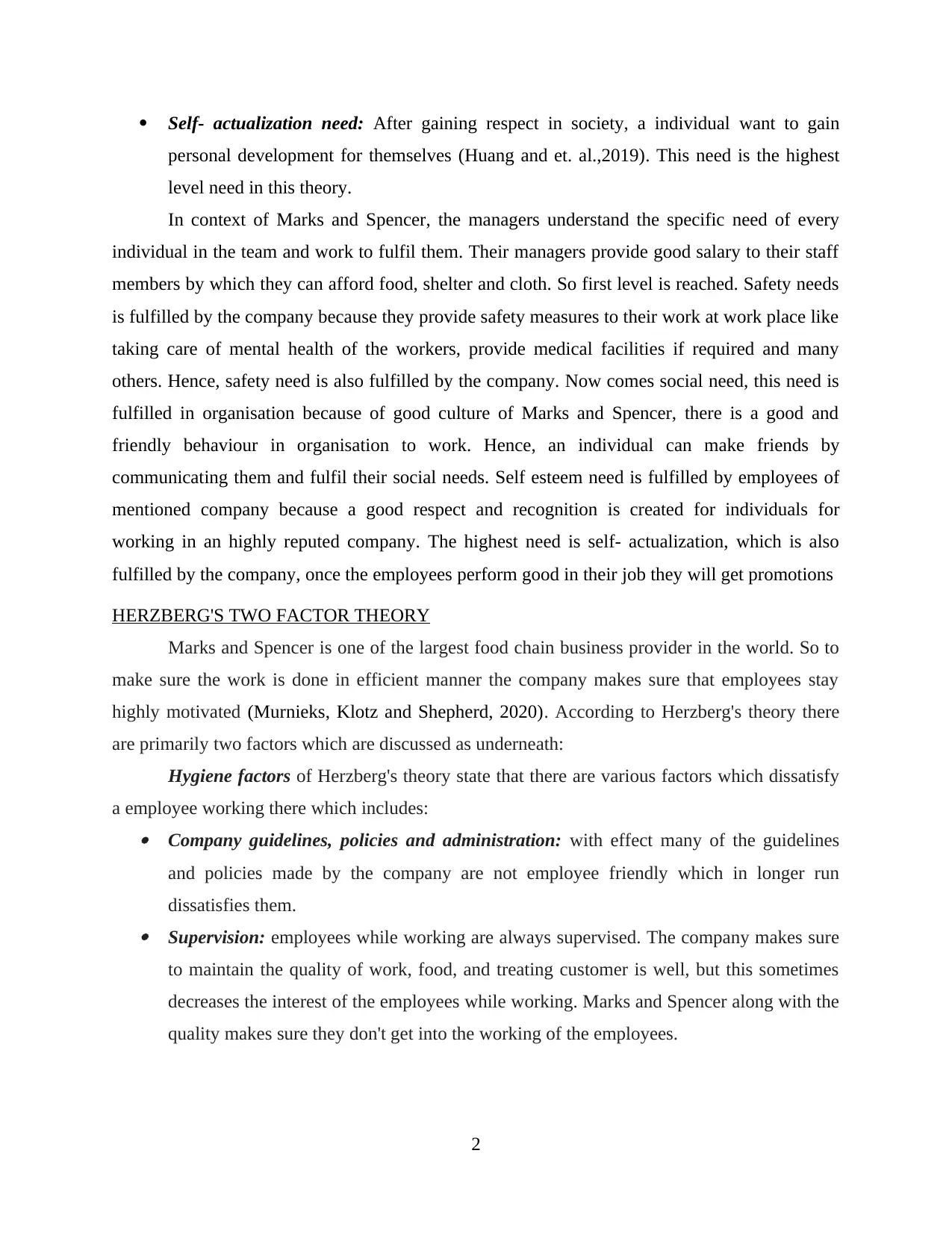
Self- actualization need: After gaining respect in society, a individual want to gain
personal development for themselves (Huang and et. al.,2019). This need is the highest
level need in this theory.
In context of Marks and Spencer, the managers understand the specific need of every
individual in the team and work to fulfil them. Their managers provide good salary to their staff
members by which they can afford food, shelter and cloth. So first level is reached. Safety needs
is fulfilled by the company because they provide safety measures to their work at work place like
taking care of mental health of the workers, provide medical facilities if required and many
others. Hence, safety need is also fulfilled by the company. Now comes social need, this need is
fulfilled in organisation because of good culture of Marks and Spencer, there is a good and
friendly behaviour in organisation to work. Hence, an individual can make friends by
communicating them and fulfil their social needs. Self esteem need is fulfilled by employees of
mentioned company because a good respect and recognition is created for individuals for
working in an highly reputed company. The highest need is self- actualization, which is also
fulfilled by the company, once the employees perform good in their job they will get promotions
HERZBERG'S TWO FACTOR THEORY
Marks and Spencer is one of the largest food chain business provider in the world. So to
make sure the work is done in efficient manner the company makes sure that employees stay
highly motivated (Murnieks, Klotz and Shepherd, 2020). According to Herzberg's theory there
are primarily two factors which are discussed as underneath:
Hygiene factors of Herzberg's theory state that there are various factors which dissatisfy
a employee working there which includes: Company guidelines, policies and administration: with effect many of the guidelines
and policies made by the company are not employee friendly which in longer run
dissatisfies them. Supervision: employees while working are always supervised. The company makes sure
to maintain the quality of work, food, and treating customer is well, but this sometimes
decreases the interest of the employees while working. Marks and Spencer along with the
quality makes sure they don't get into the working of the employees.
2
personal development for themselves (Huang and et. al.,2019). This need is the highest
level need in this theory.
In context of Marks and Spencer, the managers understand the specific need of every
individual in the team and work to fulfil them. Their managers provide good salary to their staff
members by which they can afford food, shelter and cloth. So first level is reached. Safety needs
is fulfilled by the company because they provide safety measures to their work at work place like
taking care of mental health of the workers, provide medical facilities if required and many
others. Hence, safety need is also fulfilled by the company. Now comes social need, this need is
fulfilled in organisation because of good culture of Marks and Spencer, there is a good and
friendly behaviour in organisation to work. Hence, an individual can make friends by
communicating them and fulfil their social needs. Self esteem need is fulfilled by employees of
mentioned company because a good respect and recognition is created for individuals for
working in an highly reputed company. The highest need is self- actualization, which is also
fulfilled by the company, once the employees perform good in their job they will get promotions
HERZBERG'S TWO FACTOR THEORY
Marks and Spencer is one of the largest food chain business provider in the world. So to
make sure the work is done in efficient manner the company makes sure that employees stay
highly motivated (Murnieks, Klotz and Shepherd, 2020). According to Herzberg's theory there
are primarily two factors which are discussed as underneath:
Hygiene factors of Herzberg's theory state that there are various factors which dissatisfy
a employee working there which includes: Company guidelines, policies and administration: with effect many of the guidelines
and policies made by the company are not employee friendly which in longer run
dissatisfies them. Supervision: employees while working are always supervised. The company makes sure
to maintain the quality of work, food, and treating customer is well, but this sometimes
decreases the interest of the employees while working. Marks and Spencer along with the
quality makes sure they don't get into the working of the employees.
2
Paraphrase This Document
Need a fresh take? Get an instant paraphrase of this document with our AI Paraphraser
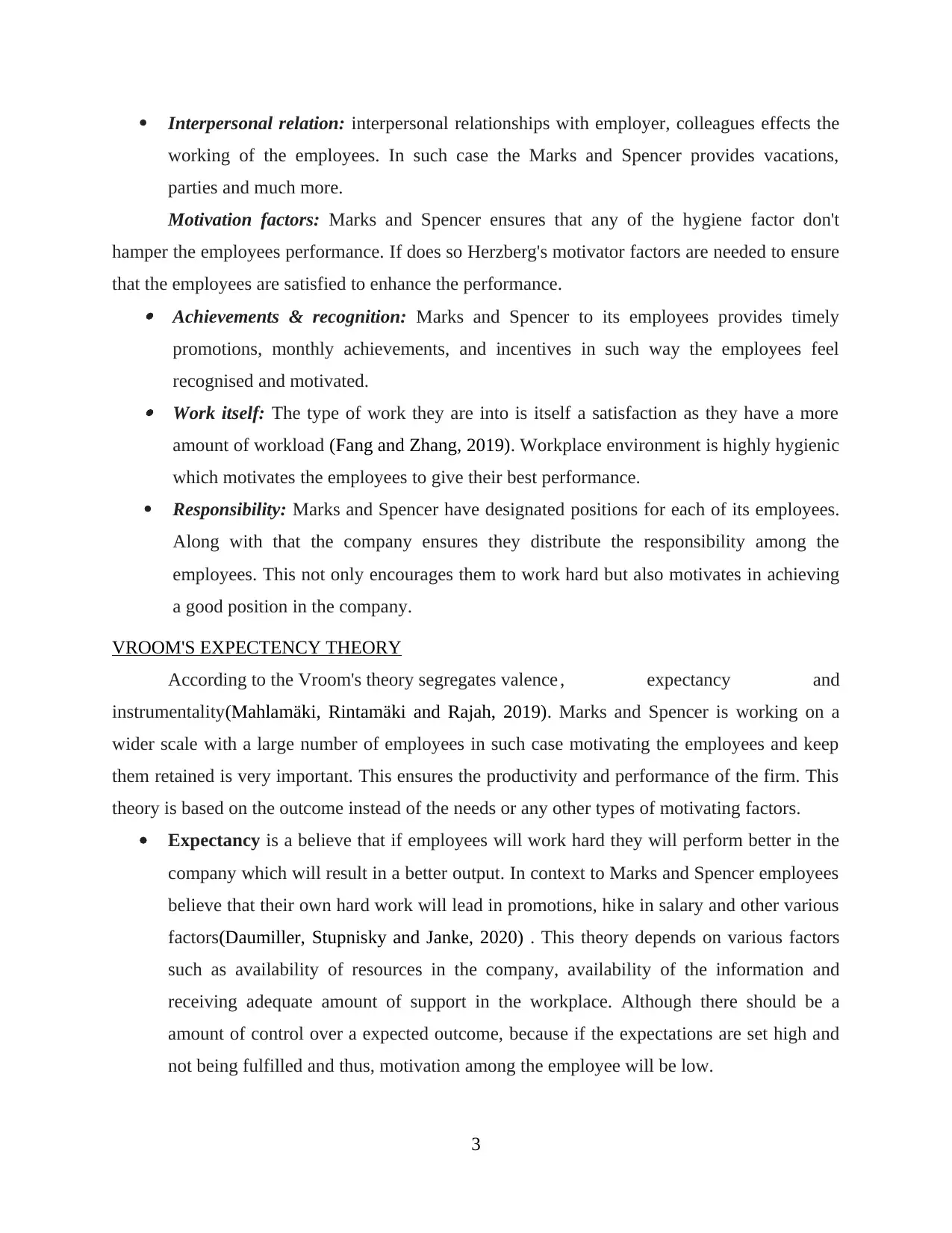
Interpersonal relation: interpersonal relationships with employer, colleagues effects the
working of the employees. In such case the Marks and Spencer provides vacations,
parties and much more.
Motivation factors: Marks and Spencer ensures that any of the hygiene factor don't
hamper the employees performance. If does so Herzberg's motivator factors are needed to ensure
that the employees are satisfied to enhance the performance. Achievements & recognition: Marks and Spencer to its employees provides timely
promotions, monthly achievements, and incentives in such way the employees feel
recognised and motivated. Work itself: The type of work they are into is itself a satisfaction as they have a more
amount of workload (Fang and Zhang, 2019). Workplace environment is highly hygienic
which motivates the employees to give their best performance.
Responsibility: Marks and Spencer have designated positions for each of its employees.
Along with that the company ensures they distribute the responsibility among the
employees. This not only encourages them to work hard but also motivates in achieving
a good position in the company.
VROOM'S EXPECTENCY THEORY
According to the Vroom's theory segregates valence , expectancy and
instrumentality(Mahlamäki, Rintamäki and Rajah, 2019). Marks and Spencer is working on a
wider scale with a large number of employees in such case motivating the employees and keep
them retained is very important. This ensures the productivity and performance of the firm. This
theory is based on the outcome instead of the needs or any other types of motivating factors.
Expectancy is a believe that if employees will work hard they will perform better in the
company which will result in a better output. In context to Marks and Spencer employees
believe that their own hard work will lead in promotions, hike in salary and other various
factors(Daumiller, Stupnisky and Janke, 2020) . This theory depends on various factors
such as availability of resources in the company, availability of the information and
receiving adequate amount of support in the workplace. Although there should be a
amount of control over a expected outcome, because if the expectations are set high and
not being fulfilled and thus, motivation among the employee will be low.
3
working of the employees. In such case the Marks and Spencer provides vacations,
parties and much more.
Motivation factors: Marks and Spencer ensures that any of the hygiene factor don't
hamper the employees performance. If does so Herzberg's motivator factors are needed to ensure
that the employees are satisfied to enhance the performance. Achievements & recognition: Marks and Spencer to its employees provides timely
promotions, monthly achievements, and incentives in such way the employees feel
recognised and motivated. Work itself: The type of work they are into is itself a satisfaction as they have a more
amount of workload (Fang and Zhang, 2019). Workplace environment is highly hygienic
which motivates the employees to give their best performance.
Responsibility: Marks and Spencer have designated positions for each of its employees.
Along with that the company ensures they distribute the responsibility among the
employees. This not only encourages them to work hard but also motivates in achieving
a good position in the company.
VROOM'S EXPECTENCY THEORY
According to the Vroom's theory segregates valence , expectancy and
instrumentality(Mahlamäki, Rintamäki and Rajah, 2019). Marks and Spencer is working on a
wider scale with a large number of employees in such case motivating the employees and keep
them retained is very important. This ensures the productivity and performance of the firm. This
theory is based on the outcome instead of the needs or any other types of motivating factors.
Expectancy is a believe that if employees will work hard they will perform better in the
company which will result in a better output. In context to Marks and Spencer employees
believe that their own hard work will lead in promotions, hike in salary and other various
factors(Daumiller, Stupnisky and Janke, 2020) . This theory depends on various factors
such as availability of resources in the company, availability of the information and
receiving adequate amount of support in the workplace. Although there should be a
amount of control over a expected outcome, because if the expectations are set high and
not being fulfilled and thus, motivation among the employee will be low.
3
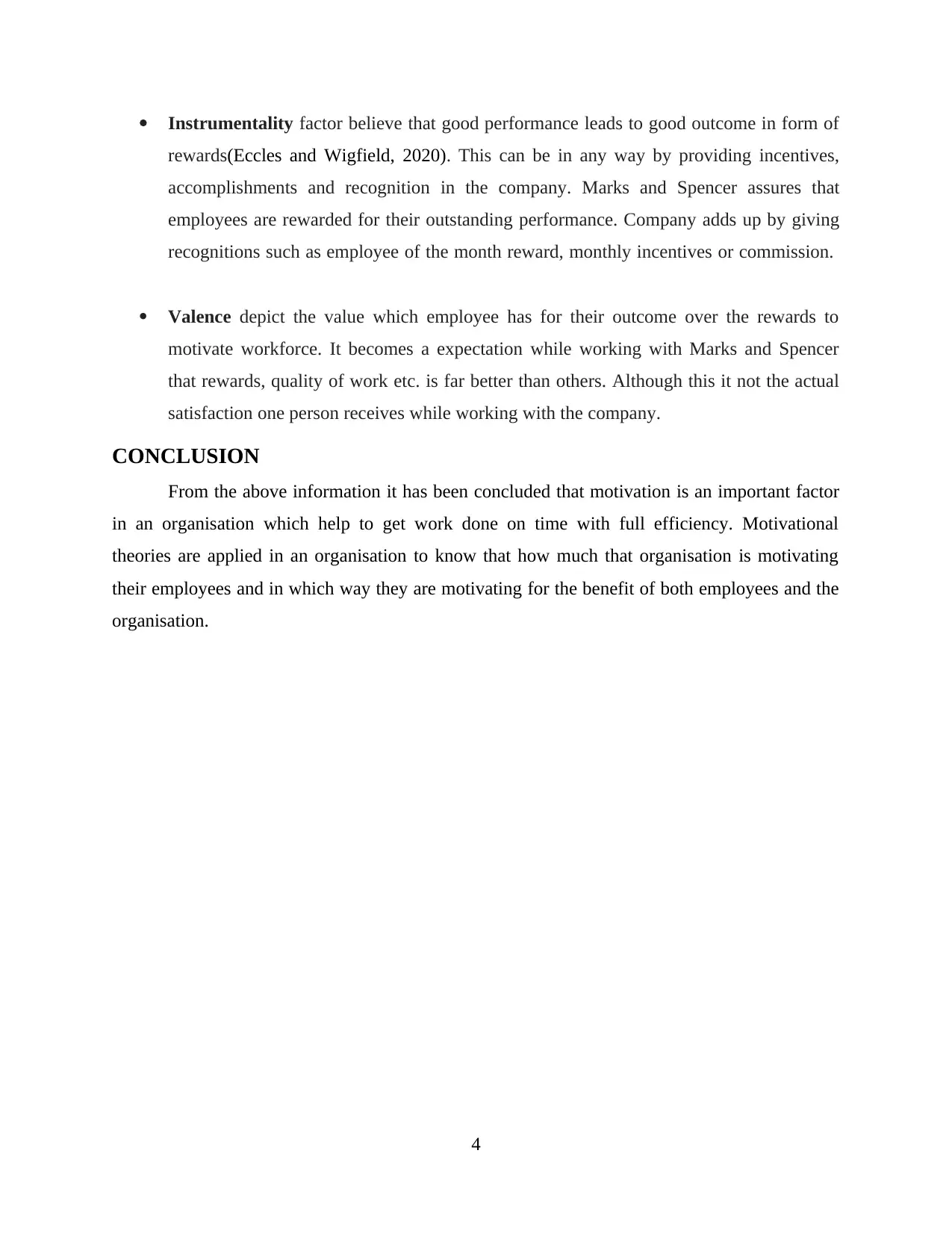
Instrumentality factor believe that good performance leads to good outcome in form of
rewards(Eccles and Wigfield, 2020). This can be in any way by providing incentives,
accomplishments and recognition in the company. Marks and Spencer assures that
employees are rewarded for their outstanding performance. Company adds up by giving
recognitions such as employee of the month reward, monthly incentives or commission.
Valence depict the value which employee has for their outcome over the rewards to
motivate workforce. It becomes a expectation while working with Marks and Spencer
that rewards, quality of work etc. is far better than others. Although this it not the actual
satisfaction one person receives while working with the company.
CONCLUSION
From the above information it has been concluded that motivation is an important factor
in an organisation which help to get work done on time with full efficiency. Motivational
theories are applied in an organisation to know that how much that organisation is motivating
their employees and in which way they are motivating for the benefit of both employees and the
organisation.
4
rewards(Eccles and Wigfield, 2020). This can be in any way by providing incentives,
accomplishments and recognition in the company. Marks and Spencer assures that
employees are rewarded for their outstanding performance. Company adds up by giving
recognitions such as employee of the month reward, monthly incentives or commission.
Valence depict the value which employee has for their outcome over the rewards to
motivate workforce. It becomes a expectation while working with Marks and Spencer
that rewards, quality of work etc. is far better than others. Although this it not the actual
satisfaction one person receives while working with the company.
CONCLUSION
From the above information it has been concluded that motivation is an important factor
in an organisation which help to get work done on time with full efficiency. Motivational
theories are applied in an organisation to know that how much that organisation is motivating
their employees and in which way they are motivating for the benefit of both employees and the
organisation.
4
⊘ This is a preview!⊘
Do you want full access?
Subscribe today to unlock all pages.

Trusted by 1+ million students worldwide
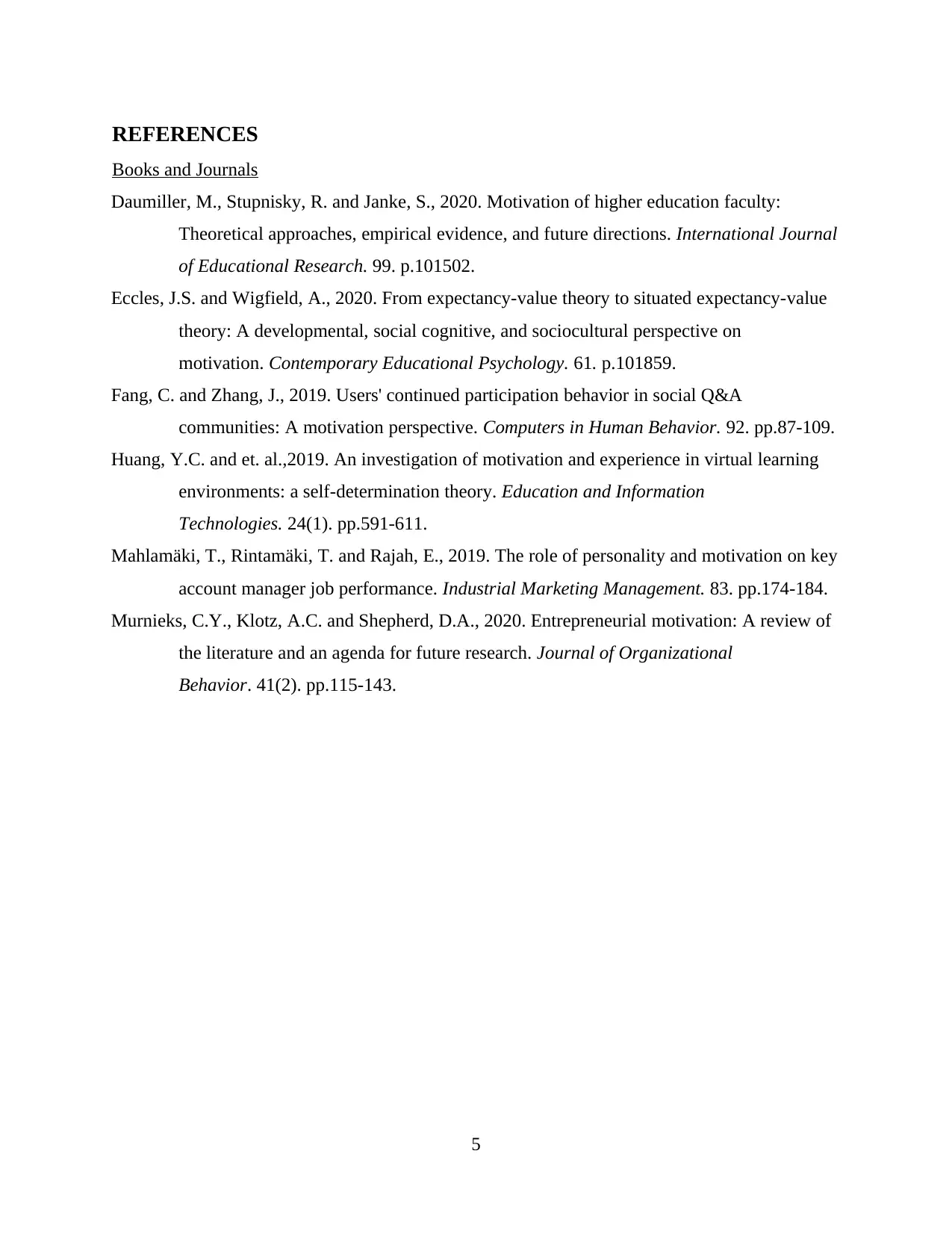
REFERENCES
Books and Journals
Daumiller, M., Stupnisky, R. and Janke, S., 2020. Motivation of higher education faculty:
Theoretical approaches, empirical evidence, and future directions. International Journal
of Educational Research. 99. p.101502.
Eccles, J.S. and Wigfield, A., 2020. From expectancy-value theory to situated expectancy-value
theory: A developmental, social cognitive, and sociocultural perspective on
motivation. Contemporary Educational Psychology. 61. p.101859.
Fang, C. and Zhang, J., 2019. Users' continued participation behavior in social Q&A
communities: A motivation perspective. Computers in Human Behavior. 92. pp.87-109.
Huang, Y.C. and et. al.,2019. An investigation of motivation and experience in virtual learning
environments: a self-determination theory. Education and Information
Technologies. 24(1). pp.591-611.
Mahlamäki, T., Rintamäki, T. and Rajah, E., 2019. The role of personality and motivation on key
account manager job performance. Industrial Marketing Management. 83. pp.174-184.
Murnieks, C.Y., Klotz, A.C. and Shepherd, D.A., 2020. Entrepreneurial motivation: A review of
the literature and an agenda for future research. Journal of Organizational
Behavior. 41(2). pp.115-143.
5
Books and Journals
Daumiller, M., Stupnisky, R. and Janke, S., 2020. Motivation of higher education faculty:
Theoretical approaches, empirical evidence, and future directions. International Journal
of Educational Research. 99. p.101502.
Eccles, J.S. and Wigfield, A., 2020. From expectancy-value theory to situated expectancy-value
theory: A developmental, social cognitive, and sociocultural perspective on
motivation. Contemporary Educational Psychology. 61. p.101859.
Fang, C. and Zhang, J., 2019. Users' continued participation behavior in social Q&A
communities: A motivation perspective. Computers in Human Behavior. 92. pp.87-109.
Huang, Y.C. and et. al.,2019. An investigation of motivation and experience in virtual learning
environments: a self-determination theory. Education and Information
Technologies. 24(1). pp.591-611.
Mahlamäki, T., Rintamäki, T. and Rajah, E., 2019. The role of personality and motivation on key
account manager job performance. Industrial Marketing Management. 83. pp.174-184.
Murnieks, C.Y., Klotz, A.C. and Shepherd, D.A., 2020. Entrepreneurial motivation: A review of
the literature and an agenda for future research. Journal of Organizational
Behavior. 41(2). pp.115-143.
5
1 out of 7
Related Documents
Your All-in-One AI-Powered Toolkit for Academic Success.
+13062052269
info@desklib.com
Available 24*7 on WhatsApp / Email
![[object Object]](/_next/static/media/star-bottom.7253800d.svg)
Unlock your academic potential
Copyright © 2020–2025 A2Z Services. All Rights Reserved. Developed and managed by ZUCOL.




